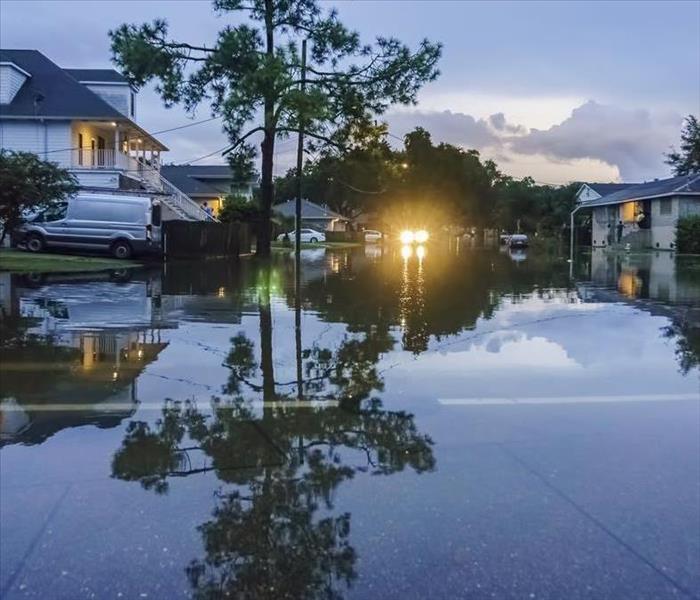Cleaning Up Flooding In My New Orleans Property- Where To Start?
5/11/2020 (Permalink)
Start by calling SERVPRO when it comes to your flood damage New Orleans.
Flooding in Louisiana is a common issue. To recoup as much of the losses as possible, shut off the source of the flooding, turn off electricity at the mains, and evacuate the property. Contacting your insurance provider and arranging professional restoration services here in New Orleans can help you recover losses quickly.
How does flooding occur and who is responsible?
Most floods are the result of natural forces. Homeowners with flood damage in New Orleans tend to be the victims of storm fallout and other natural sources. However, some property flooding may occur from internal plumbing issues. The source of flooding can be relevant to some insurance providers, so you should ensure you have coverage for both internal and external causes. It is frequently up to the homeowner to arrange for a restoration company who can then work with your insurance adjuster to bring the home back to its original condition.
How can I reduce the damages of a nearby road overflow?
Road overflows can occur when drainage or sewer systems become overloaded. The resulting water can reach your private property causing substantial harm. Reporting the issue to the local council can help your property's recovery because the source of water can be shut off. In the meantime, you may want to focus your efforts on blocking water intrusion. You can achieve this by sealing doorways or other entry points as well as moving items to the upper level.
What can emergency mitigation procedures help to prevent permanent losses during a flood?
- Shutting off or neutralizing the source of water entering the property
- Sealing or blocking potential points of entry into the home
- Extracting of large bodies of water in an efficient manner
- Securing the property against unlawful trespass
- In some situations, pre-cleaning of property materials like carpeting can be beneficial and prevent soiling from settling into materials
- Moving furniture out of harm's way including blocking furniture to raise it above the standing water level
How can I tell if my home is suffering structural flood damage or could potentially collapse?
Tell-tale signs of severe flooding issues may include sagging of ceilings or floors in the property. There may also be signs of significant stress in jointing, although we may need to demolish sections of drywall to assess the framework in your home correctly. Waterlogging can occur when standing water migrates below floors but becomes trapped inside the cavity. The additional weight and water pressure can exert a massive amount of pressure, which can lead to structural collapse. SERVPRO technicians inspect the subfloor thoroughly during scoping inspections to ensure that water is extracted from these pressure points.
How can you help to reduce the damage to my contents?
While the structure may be the immediate concern in flood restoration, we also pay close attention to your possessions. In severely affected properties, SERVPRO can enact a pack out or move out procedure. Move-outs involve gathering data on the condition of all your possessions before professionally moving them to a secure storage facility. At our storage facility, we can then perform advanced restoration on possessions.
What are external contents restoration services available for severely flooded homes?
- Dry cleaning of sensitive fabrics or materials in the home
- Special restoration services, including document drying, electronic restoration services, mechanical washing, and immersion cleaning.
- Deodorization as well as disinfecting of fabrics
- Appropriate drying of all items to prevent mold growth or other microbial issues
How can you protect my home from secondary damages after flooding?
Preventing secondary harm after a flood relies on making sure that structural restoration is thorough. Many building materials in the home are porous and can absorb harmful floodwaters. Our technicians can perform controlled demolition of building materials such as areas of drywall exposed to floodwater. By ventilating the cavities behind drywall, we can eliminate the conditions needed for microbial bacteria to grow. Using air-moving equipment as well as taking regular moisture content analysis, we can ensure that cavities are appropriately dry before re-installation of clean building materials.
What are the stages of flood restoration?
- Emergency mitigation to reduce or prevent further damages including water extraction, building board-ups, and inspections
- Cleaning and disinfecting the affected area
- Setting up a drying procedure to prevent mold growth and return your home to a habitable condition
- Deodorizing the property thoroughly using misters, foggers, pellets and spray-on deodorants
- Treating the property with anti-microbial chemicals
- Performing restoration on the property to return it to its preloss condition
Flooding can occur rapidly and often be beyond the homeowner's control. Using a specialist restoration service can help to save you losses in the short, medium, and long-term. Our technicians are experienced practitioners of water restoration with the correct equipment to ensure we complete our work on time and budget.
If your property falls victim to road overflow or storm-related flooding, contact SERVPRO of The New Orleans Westbank at (504) 348-7526.






 24/7 Emergency Service
24/7 Emergency Service
